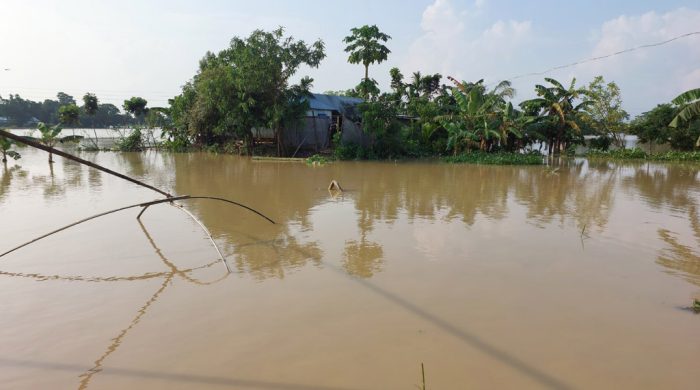Flood puts hundreds at risk of starvation

- Update Time : Wednesday, October 9, 2024
- 16 Time View

The ongoing flash flooding puts hundreds of farmer families at immediate risk of starvation in Sherpur district, washing away the rice they stored from the previous harvest and also destroying the standing paddy fields.
The divisional office of the Department of Agricultural Extension estimated that the flood affected 97,000 hectares of standing aman paddy fields, over 98 per cent of which are located in Nalitabari, Jhinaigati and Sribardi upazilas of the district.
Over half of the affected areas in the three upazilas lay completely submerged as of Tuesday.
‘The flash flood has badly hit aman crop, completely wiping it out in some areas,’ said Ommey Salma Tanzia, divisional commissioner of Mymensingh which includes Sherpur.
Nalitabari and Jhinaigati upazilas have emerged as the worst affected as nearly all the standing aman fields there have been destroyed.
The affected three Sherpur upazilas border India and are remotely located with the farmers having the least access to resources. Hundreds of farming families there live in mud-built houses, scores of which have also been washed away in the flash floods.
Like in most regions in the country, farmers in Sherpur also grow boro and aman —two rice crops mainly. The harvest from the boro crop sustains them between May and November, while aman supplies them food the rest of the time.
‘Many farmers could not save anything during the flood,’ said Ranajit Chisim, 45, a resident of Nolkura village in Jhinaigati, who lost two of his three mud-built houses.
Lucky to be present at home when the flood hit his house about 9:00am on October 4, Ranajit managed to save some of his belongings.
But those who left early for work returned to find all their belongings wiped away by the flood, even all the grains stored in their family silos. Their next rice crop aman standing in the field was also gone.
Authorities are yet to come up with an estimate of the number of farmers, which includes deprived national minority families, caught in such an intense situation.
The standing aman was due in November. Aman that usually survives the regular floods cannot endure the massive current of flash floods.
‘We will give the farmers an incentive of free seeds and fertiliser in the next winter,’ said Salma Akther, additional director posted at the DAE divisional office in Mymensingh.
Around half of the over seven lakh inhabitants in the three affected Sherpur upazilas are landless farmers who grow crops with high-interest micro-credits.
Farmers also lost their domesticated animals and fish farms.
The divisional office of the fisheries department said that Sherpur suffered the most in fisheries losses with 1300 hecatres of its fish farms swept away.
As water receded in the worst-hit areas, people returned home trying to start rebuilding.
The Sherpur deputy commissioner’s office sought 8,000 bundles of corrugated iron sheet to help roughly 4,000 families to rebuild their houses.
The flood so far killed eight people in the district.
The Jamalpur district relief and rehabilitation office said that 15 houses along the River Jinjiram had been lost to erosion.
On October 8, the Flood Forecasting and Warning Centre reported that the Jinjiram River was flowing 99cm above its danger mark at Goalkanda in Jamalpur while the Someswari River was flowing 28cm above its danger mark at Kalmakanda in Netrakona.
The flooding in the low-lying areas of Netrakona, Mymensingh and Jamalpur districts might take three more days to improve.
The flood washed away embankments at numerous places, potentially leading to waterlogging that will be very hard to get rid of.
Some of the areas in Feni, Cumilla and Noakhali districts are yet to get rid of the waterlogging caused by the flash flood that hit in the third week of August.
A Centre for Policy Dialogue analysis released on October 7 revealed its estimation of the country’s total loss from the August flood at around Tk 14,421 crore.
The agriculture and forestry sector suffered the worst with damage estimated at Tk 5,169.71 crore—which is 35.85 per cent of the total damage, the analysis said.
The overall rainfall drastically fell over the last two days, indicating an improvement in the flood situation soon.
In the 24 hours until 6:00am on Tuesday, Bangladesh’s maximum rainfall of 16mm was recorded in Tangail.
The Bangladesh Meteorological Department predicted light to moderate rain accompanied by temporary gusty wind at many places over Mymensingh and Sylhet divisions, and at a few places over Rajshahi, Rangpur, Dhaka, Khulna, Barishal and Chattogram divisions today.















